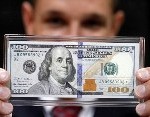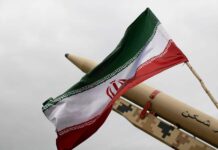 A printing problem with the new high-tech $100 bills has forced government printers to shut down production – and to quarantine more than one billion of the notes. The flawed notes represent more than ten percent of the U.S. currency on the entire planet.
A printing problem with the new high-tech $100 bills has forced government printers to shut down production – and to quarantine more than one billion of the notes. The flawed notes represent more than ten percent of the U.S. currency on the entire planet.
They are being stored in giant vaults at Fort Worth in Texas and in Washington, DC, as the Federal Reserve desperately tries to resolve the problem.
Meanwhile, printers have begun reprinting the old $100 notes – without the high-tech security features and still bearing the signature of George W Bush’s treasury secretary, Hank Paulson – in order to prevent a cash flow crisis.
With the holiday shopping season in full swing, authorities are scrambling to do everything they can to keep U.S. cash flowing.
‘There is something drastically wrong here,’ one source told CNBC. ‘The frustration level is off the charts.’
The new high-tech bills were initially scheduled for release in February of 2011. They were due to be the first in circulation that bore the signature of President Obama’s treasury secretary, Timothy Geithner.
The new notes were to feature new sophisticated security features such as a 3D security strip and a colour-shifting image of a bell.
The features – announced with great fanfare by the Treasury Department and the Federal Reserve – were designed to foil counterfeiters.
But it turns out those who designed the new notes may have been flying too close to the sun, for the process of producing them in their billions with all the new security features is so complex that it has foiled the government printers.
CNBC sources claimed that printers have produced 1.1billion of the new bills – but those bills are unusable because of a creasing problem.
The paper folds over during production – revealing a blank, unlinked portion of the bill face.
After printing, officials discovered that some of the new bills have a vertical crease that, when the sides of the bill are pulled, unfolds and reveals a blank space on the face of the bill.
At first glance, the bills appear completely printed – but they are not.
Another source claimed that at the height of the problem up to 30 per cent of the bills rolling off the presses included the flaw. As officials are not certain exactly which of the notes are flawed, it means that all of the notes that have been printed are having to be quarantined – all $110 billion of them.
HOW ARE U.S. BANK NOTES PRODUCED?
The printing of American dollar bills is a long and convoluted process.
The paper on which all U.S. bank notes are printed is manufactured and supplied by Crane & Company.
The company has supplied the government with paper continually since 1879.
The Treasury Department and its Bureau of Engraving and Printing handle the design and production of the bills.
However they do not get much of the glory: As the currency is actually issued by the Federal Reserve, each note is emblazoned with the phrase ‘Federal Reserve Note’.
WHAT FEATURES DOES THE NEW $100 BILL HAVE?
More than a decade of research has gone into the security features on the redesigned $100 bill.
The Treasury has already redesigned the $5, $10, $20 and $50 notes.
The new $100 bill features a blue, 3D security strip that pictures bells that change to 100s as the strip is tilted.
The ribbon is woven into the paper, not printed on it, which is why it is the focus of speculation as a potential cause of the paper creasing problem on the printing presses.
The note also features another colour-shifting image, of a bell inside an inkwell. The bell shifts color from copper to green as the bill is tilted.
The sheer numbers are staggering. Authorities estimated that sorting through the enormous pile of bills by hand could take 20 to 30 years.
Instead they are developing a mechanised way of sorting the usable notes from the flawed ones – a process that they hope will only take a year. There was no estimate on how much the sorting process will cost.
A government source told CNBC that the total supply of U.S. currency on the planet is $930billion in bank notes.
A view of Fort Worth in Texas. Many of the faulty bills are being stored in giant vaults there as the government develops a way to sort through them
The defective bills – which are the most costly ever produced – will simply have to be burned. The American taxpayer paid 12 cents to produce each note, roughly twice the cost of previous bills, meaning roughly $120million is about to go up in flames.
The Fed issued a press release on October 1 announcing a ‘delay in the issue date’ of the new bills due to a ‘problem with sporadic creasing of the paper’.
But, until now, the full extent of the problem – and its cost – has largely been hidden from public view.
Officials are trying not to assign blame – publicly at least.
But sources claim the finger-pointing has already begin. ‘The Fed’s very unhappy, and the Bureau of Engraving and Printing is taking a beating unnecessarily,’ CNBC quoted one official as saying. ‘Somebody has to pay for this.’
{Daily Mail/Matzav.com}












Sounds like The Fed should have spent a few hundred dollars of that stimulus money and purchase a license of FlightCheck for checking print-jobs! Beyond that though, how or why was the pressman not checking the print-run throughout the press-run?
yikes
If these could somehow be ‘tagged’ and made ‘unspendable’ – I’m sure they could be sold to collectors at at least face value – generating a profit!
Only the $100 bills were quarantined – good thing, otherwise we might be mechayiv in pidyon shvuyim for Oorah’s Fiveish!
Get these damaged notes to collectors. There’s a fortune to be made.I’ll gladly pay face value and wait until they get it right.